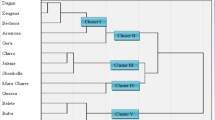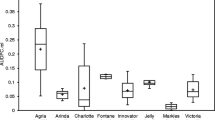Abstract
Two field experiments conducted over three years at Les Buissons, Quebec demonstrated a causal relationship between the black scurf stage and the disease phase ofRhizoctonia solani on potato cultivars Green Mountain and Norland.
Planting sclerotia infested seed pieces as compared to sclerotia-free seed pieces resulted in a significant reduction in total yield, marketable yield, number of tubers, mean tuber weight, specific gravity and sometimes in total number of main stems and stolons. Daughter tubers bearing sclerotia were significantly more numerous from sclerotia infested seed sets.
Compendio
Dos experimentos conducidos durante tres años en Les Buissons, Quebec, demostraron una relación causal entre el estado de costra negra y la fase patógena deRhizoctonia solani Kuhn sobre los cultivares de papa Green Mountain y Norland.
Sembrando porciones de tubérculos-semillas infestados con esclerocios y comparándolas con porciones de tubérculos-semillas libres de esclerocios se encontró una reductión significativa en el rendimiento total, rendimiento comerciable, número de tubérculos, peso promedio de tubérculo, gravedad especifica y algunas veces en el número total de tallos principales y estolones.
Los grupos de tubérculos-semillas infestados con esclerocios produjeron tubérculos que eran portadores de un número significativamente mayor de esclerocios.
Similar content being viewed by others
Literature Cited
Bolkan, H.A., H.T. Wenham and K.S. Milne. 1974. Effect of soil temperature on severity ofRhizoctonia solani infection on potato shoots. Plant Dis Rep 58: 646–649.
Frank, J. A. and S.S. Leach. 1980. Comparison of tuber-borne and soilborne inoculum in the Rhizoctonia disease of potato. Phytopathology 70: 51–53.
Gudmestad, N.C., R.T. Zink and J.E. Huguelet. 1979. The effect of harvest date and tuber-borne sclerotia on the severity of Rhizoctonia disease of potato. Am Potato J 56: 35–41.
Hide, G.A., J.M. Hirst and O.J. Stedman. 1973. Effects of black scurf (Rhizoctonia solani) on potatoes. Ann Appl Biol 74: 139–148.
James, W.C. and A.R. McKenzie. 1972. The effect of tuber-borne sclerotiaof Rhizoctonia solani Kühn on the potato crop. Am Potato J 49: 296–301.
LeClerg, E.L., W.H. Leonard and A.G. Clark. 1962. Field plot technique. 2nd. edition. Burgess Publishing Co., Minneapolis. 373 pp.
Otrysko, B.E., G.J. Banville and A. Asselin. 1988. Influence du degré de dépendance des tubercules-fils de pommes de terre vis-á-vis de la plante-mére sur leur infestation parRhizoctonia solani. Potato Res 31: 617–625.
Weinhold, A.R., T. Bowman, and D.H. Hall. 1982. Rhizoctonia disease of potato: effect on yield and control by seed tuber treatment. Phytopathology 66: 815–818.
Author information
Authors and Affiliations
Additional information
Contribution no. 373 of the Service de recherche en Phytotechnie de Québec.
Rights and permissions
About this article
Cite this article
Banville, G.J. Yield losses and damage to potato plants caused by Rhizoctonia solani Kuhn. American Potato Journal 66, 821–834 (1989). https://doi.org/10.1007/BF02853963
Accepted:
Issue Date:
DOI: https://doi.org/10.1007/BF02853963




